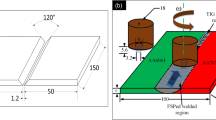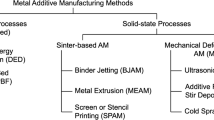Abstract
As a fourth-generation biodegradable material for biomedical applications, magnesium alloys are widely used for their light weight, low modulus, and biocompatibility, but their hardness and corrosion resistance need to be improved. AZ-series Mg alloys have been studied intensively. However, they contains Al which is hazardous to human health. WE43 Mg alloy is another promising alloy that is applied in automotive and aerospace for its corrosion resistance and stability at high temperatures (up to 300 °C). But its corrosion resistance in biological fluids is still lacking and needs further improvement. Friction stir processing (FSP) is a promising surface modification technique that able to refine the microstructure significantly and improves the corrosion resistance. In this research, the effect of rotational speed and traverse speed on the macro and microstructure as well as microhardness of Mg alloy WE43, and corrosion resistance in phosphate buffer saline, has been examined and determined. Subsequently, FSP parameters were analyzed and optimized by using response surface methodology with central-composite-design, and the mathematical models were obtained. The predicted results from models were consistent with the experiments. The SEM examinations showed that FSP reduced the average grain size from 6.64 μm for BM to as low as 4.32 μm. Additionally, the highest microhardness value was 87.1 HV (increase by 15.3%) at 1250 rpm and 30 mm/min. The best sample (B2) showed a reduction in corrosion rate compared with base metal by 5%. These results raise the potential of applying FSP to advance the application of WE43 for biomedical implants.















Similar content being viewed by others
Data Availability
The authors confirm that the data supporting the findings of this study are available within the article and its Supplementary material. Raw data that support the findings of this study are available from the corresponding author, upon reasonable request.
References
Ahmadkhaniha, D.; Heydarzadeh Sohi, M.; Zarei-Hanzaki, A.: Optimisation of friction stir processing parameters to produce sound and fine grain layers in pure magnesium. Sci. Technol. Weld. Join. 19, 235–241 (2013). https://doi.org/10.1179/1362171813y.0000000186
Sahoo, B.N., et al.: Microstructural modification and its effect on strengthening mechanism and yield asymmetry of in-situ TiC-TiB2/ AZ91 magnesium matrix composite. Mater. Sci. Eng., A 724, 269–282 (2018). https://doi.org/10.1016/j.msea.2018.03.060
Dutta, S.; Gupta, S.; Roy, M.: Recent developments in magnesium metal-matrix composites for biomedical applications: a review. ACS Biomater. Sci. Eng. 6, 4748–4773 (2020). https://doi.org/10.1021/acsbiomaterials.0c00678
Liu, J., et al.: Comparative in vitro study on binary Mg-RE (Sc, Y, La, Ce, Pr, Nd, Sm, Eu, Gd, Tb, Dy, Ho, Er, Tm, Yb and Lu) alloy systems. Acta Biomater. 102, 508–528 (2020). https://doi.org/10.1016/j.actbio.2019.11.013
Weng, W., et al.: A review of the physiological impact of rare earth elements and their uses in biomedical Mg alloys. Acta Biomater. 130, 80–97 (2021). https://doi.org/10.1016/j.actbio.2021.06.004
Liu, D., et al.: Mechanical properties, corrosion resistance and biocompatibilities of degradable Mg-RE alloys: a review. J. Market. Res. 8, 1538–1549 (2019). https://doi.org/10.1016/j.jmrt.2018.08.003
Windhagen, H., et al.: Biodegradable magnesium-based screw clinically equivalent to titanium screw in hallux valgus surgery: short term results of the first prospective, randomized, controlled clinical pilot study. Biomed. Eng. Online 12, 62 (2013). https://doi.org/10.1186/1475-925X-12-62
Cao, G., et al.: Microstructure and properties of nano-hydroxyapatite reinforced WE43 alloy fabricated by friction stir processing. Materials (Basel) (2019). https://doi.org/10.3390/ma12182994
Wu, B., et al.: The influence of reinforcement particles friction stir processing on microstructure, mechanical properties, tribological and corrosion behaviors: a review. J. Market. Res. 20, 1940–1975 (2022). https://doi.org/10.1016/j.jmrt.2022.07.172
Cao, B., et al.: Heterogenous columnar-grained high-entropy alloys produce exceptional resistance to intermediate-temperature intergranular embrittlement. Scripta Mater. 194, 113622 (2021). https://doi.org/10.1016/j.scriptamat.2020.11.007
Romero-Resendiz, L., et al.: Heterostructured stainless steel: properties, current trends, and future perspectives. Mater. Sci. Eng. R: Rep. 150, 100691 (2022). https://doi.org/10.1016/j.mser.2022.100691
Sharahi, H.J.; Pouranvari, M.; Movahedi, M.: Strengthening and ductilization mechanisms of friction stir processed cast Mg–Al–Zn alloy. Mater. Sci. Eng. A 781, 139249 (2020). https://doi.org/10.1016/j.msea.2020.139249
Zhang, D., et al.: Superplastic tensile behavior of a fine-grained AZ91 magnesium alloy prepared by friction stir processing. Mater. Sci. Eng., A 556, 100–106 (2012). https://doi.org/10.1016/j.msea.2012.06.063
Surya Kiran, G.V.V., et al.: Machining characteristics of fine grained AZ91 Mg alloy processed by friction stir processing. Trans. Nonferrous Metals Soc. China 27, 804–811 (2017). https://doi.org/10.1016/S1003-6326(17)60092-X
Li, J., et al.: Microstructures and mechanical properties of WE43 magnesium alloy prepared by friction stir processing. Rare Met. 39, 1267–1272 (2014). https://doi.org/10.1007/s12598-014-0306-3
Vasu, C., et al.: Microstructure, mechanical and corrosion properties of friction stir processed ZE41 Mg alloy. Mater. Today: Proc. 15, 50–56 (2019). https://doi.org/10.1016/j.matpr.2019.05.023
Mishra, R.S.; Ma, Z.Y.: Friction stir welding and processing. Mater. Sci. Eng. R. Rep. 50, 1–78 (2005). https://doi.org/10.1016/j.mser.2005.07.001
Commin, L., et al.: Friction stir welding of AZ31 magnesium alloy rolled sheets: Influence of processing parameters. Acta Mater. 57, 326–334 (2009). https://doi.org/10.1016/j.actamat.2008.09.011
McCafferty, E.: Introduction to Corrosion Science, p. 1–575. Springer, New York (2010)
Yousefpour, F.; Jamaati, R.; Aval, H.J.: Effect of traverse and rotational speeds on microstructure, texture, and mechanical properties of friction stir processed AZ91 alloy. Mater. Char. (2021). https://doi.org/10.1016/j.matchar.2021.111235
Nakata, K., et al.: Improvement of mechanical properties of aluminum die casting alloy by multi-pass friction stir processing. Mater. Sci. Eng., A 437, 274–280 (2006). https://doi.org/10.1016/j.msea.2006.07.150
Huang, Y., et al.: Microstructure and surface mechanical property of AZ31 Mg/SiCp surface composite fabricated by Direct Friction Stir Processing. Mater. Des. 59, 274–278 (2014). https://doi.org/10.1016/j.matdes.2014.02.067
Patel, V.V.; Badheka, V.J.; Kumar, A.: Influence of pin profile on the tool plunge stage in friction stir processing of Al–Zn–Mg–Cu alloy. Trans. Indian Inst. Met. 70, 1151–1158 (2017). https://doi.org/10.1007/s12666-016-0903-y
Zhou, L., et al.: Microstructure and mechanical properties of friction stir processed TA5 alloy. Trans. Nonferrous Metals Soc. China 31, 404–415 (2021). https://doi.org/10.1016/s1003-6326(21)65505-x
Mehdi, H.; Mishra, R.S.: Effect of friction stir processing on mechanical properties and heat transfer of TIG welded joint of AA6061 and AA7075. Defence Technol. 17, 715–727 (2021). https://doi.org/10.1016/j.dt.2020.04.014
Cartigueyen, S.; Mahadevan, K.: Study of friction stir processed zone under different tool pin profiles in pure copper. IOSR J. Mech. Civ. Eng. 11, 06–12 (2014). https://doi.org/10.9790/1684-11270612
Senthilkumar, R., et al.: The effect of the number of passes in friction stir processing of aluminum alloy (AA6082) and its failure analysis. Appl. Surf. Sci. 491, 420–431 (2019). https://doi.org/10.1016/j.apsusc.2019.06.132
Moustafa, E.: Effect of multi-pass friction stir processing on mechanical properties for AA2024/Al2O3 nanocomposites. Materials (Basel) (2017). https://doi.org/10.3390/ma10091053
Ahmadkhaniha, D., et al.: Formations of AZ91/Al2O3 nano-composite layer by friction stir processing. J. Magn. Alloys 4, 314–318 (2016). https://doi.org/10.1016/j.jma.2016.11.002
Dinaharan, I., et al.: Development of titanium particulate reinforced AZ31 magnesium matrix composites via friction stir processing. J. Alloys Compd. (2020). https://doi.org/10.1016/j.jallcom.2019.153071
Khayyamin, D.; Mostafapour, A.; Keshmiri, R.: The effect of process parameters on microstructural characteristics of AZ91/SiO2 composite fabricated by FSP. Mater. Sci. Eng., A 559, 217–221 (2013). https://doi.org/10.1016/j.msea.2012.08.084
Liu, F., et al.: Enhancing corrosion resistance and mechanical properties of AZ31 magnesium alloy by friction stir processing with the same speed ratio. J. Alloys Compd. 829, 154452 (2020). https://doi.org/10.1016/j.jallcom.2020.154452
Zeng, Y., et al.: Effect of Mg24Y5 intermetallic particles on grain refinement of Mg-9Li alloy. Intermetallics 45, 18–23 (2014). https://doi.org/10.1016/j.intermet.2013.09.005
Eivani, A.R., et al.: Applying multi-pass friction stir processing to refine the microstructure and enhance the strength, ductility and corrosion resistance of WE43 magnesium alloy. J. Market. Res. 12, 1946–1957 (2021). https://doi.org/10.1016/j.jmrt.2021.03.021
Peng, P., et al.: Relationship between microstructure and mechanical properties of friction stir processed AISI 316L steel produced by selective laser melting. Mater. Char. 163, 110283 (2020). https://doi.org/10.1016/j.matchar.2020.110283
Ren, R., et al.: Hall-Petch relationship and deformation mechanism of pure Mg at room temperature. J. Alloys Compd. 920, 165924 (2022). https://doi.org/10.1016/j.jallcom.2022.165924
Ding, C., et al.: Superhydrophobic composite coating with active corrosion resistance for AZ31B magnesium alloy protection. Chem. Eng. J. 357, 518–532 (2019). https://doi.org/10.1016/j.cej.2018.09.133
Argade, G.R., et al.: Corrosion behavior of a friction stir processed rare-earth added magnesium alloy. Corros. Sci. 58, 321–326 (2012). https://doi.org/10.1016/j.corsci.2012.01.007
Acknowledgments
This work was supported by the Konsortium Kecemerlangan Penyelidikan (KKP)—Ministry of Higher Education (KKP001-2021), Deanship of Scientific Research at King Khalid University—the Large Groups Project (Grant No. RGP.2/63/43), and the National Natural Science Foundation of China (Grant No. 51275414, No. 51605387).
Author information
Authors and Affiliations
Corresponding author
Ethics declarations
Conflict of interest
The authors declare that they have no conflict of interest.
Rights and permissions
Springer Nature or its licensor (e.g. a society or other partner) holds exclusive rights to this article under a publishing agreement with the author(s) or other rightsholder(s); author self-archiving of the accepted manuscript version of this article is solely governed by the terms of such publishing agreement and applicable law.
About this article
Cite this article
Wu, B., Yusof, F., Li, F. et al. Influence of Friction Stir Processing Parameters on Microstructure, Hardness and Corrosion Resistance of Biocompatible Mg Alloy WE43. Arab J Sci Eng 49, 1897–1911 (2024). https://doi.org/10.1007/s13369-023-08037-8
Received:
Accepted:
Published:
Issue Date:
DOI: https://doi.org/10.1007/s13369-023-08037-8




